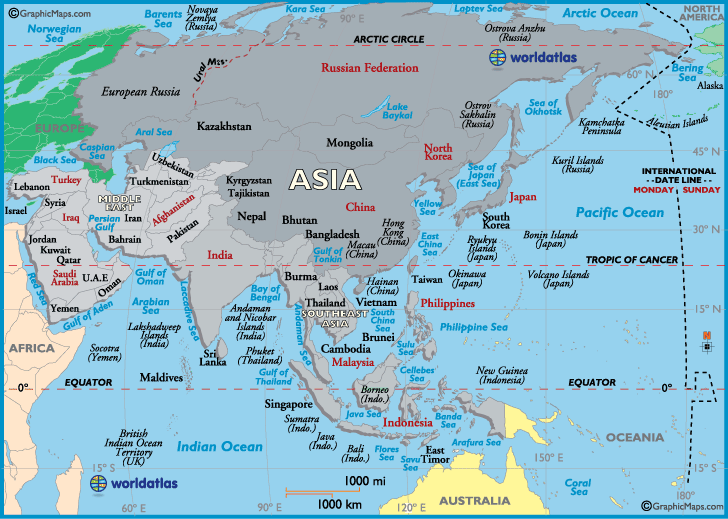Asia
Asia is the world’s largest continent both by population and by land area. Comprising of 30% of the world’s land area, Asia borders the Pacific Ocean in the east, the Arctic Ocean in the north, the Indian Ocean in the south, and Europe to the west. Around 60% of the world’s population lives in Asia.
Asia has the longest coastline of any continent. The climate of Asia is very diverse, and ranges from arctic to tropical. Throughout the interior of Asia, the climate is mostly dry. The southern and eastern part of the continent is prone to tropical storms called monsoons. Animals that are unique to Asia include the Asian elephant, the Indian Cobra, and the Japanese macaque.
Over four billion people live in Asia. China is the most populated country in Asia, though it is predicted that the population of India will overtake that of China by 2022. Asia is home to some of the world’s most important economic centers including Hong Kong, Tokyo, Shanghai, and Seoul.
In general terms, Asia is bounded on the east by the Pacific Ocean, on the south by the Indian Ocean, and on the north by the Arctic Ocean. The border of Asia with Europe is a historical and cultural construct, as there is no clear physical and geographical separation between them. It is somewhat arbitrary and has moved since its first conception in classical antiquity. The division of Eurasia into two continents reflects East–West cultural, linguistic, and ethnic differences, some of which vary on a spectrum rather than with a sharp dividing line. The most commonly accepted boundaries place Asia to the east of the Suez Canal separating it from Africa; and to the east of the Turkish Straits, the Ural Mountains and Ural River, and to the south of the Caucasus Mountains and the Caspian and Black Seas, separating it from Europe.
History
The history of Asia can be seen as the distinct histories of several peripheral coastal regions: East Asia, South Asia, Southeast Asia and the Middle East, linked by the interior mass of the Central Asian steppes.
The coastal periphery was home to some of the world's earliest known civilizations, each of them developing around fertile river valleys. The civilizations in Mesopotamia, the Indus Valley and the Yellow River shared many similarities. These civilizations may well have exchanged technologies and ideas such as mathematics and the wheel. Other innovations, such as writing, seem to have been developed individually in each area. Cities, states and empires developed in these lowlands.
The central steppe region had long been inhabited by horse-mounted nomads who could reach all areas of Asia from the steppes. The earliest postulated expansion out of the steppe is that of the Indo-Europeans, who spread their languages into the Middle East, South Asia, and the borders of China, where the Tocharians resided. The northernmost part of Asia, including much of Siberia, was largely inaccessible to the steppe nomads, owing to the dense forests, climate and tundra. These areas remained very sparsely populated.
Geography and Climate
Asia is the largest continent on Earth. It covers 9% of the Earth's total surface area (or 30% of its land area), and has the longest coastline, at 62,800 kilometres (39,022 mi). Asia is generally defined as comprising the eastern four-fifths of Eurasia. It is located to the east of the Suez Canal and the Ural Mountains, and south of the Caucasus Mountains (or the Kuma–Manych Depression) and the Caspian and Black Seas. It is bounded on the east by the Pacific Ocean, on the south by the Indian Ocean and on the north by the Arctic Ocean. Asia is subdivided into 48 countries, three of them (Russia, Kazakhstan and Turkey) having part of their land in Europe.
Asia has extremely diverse climates and geographic features. Climates range from arctic and subarctic in Siberia to tropical in southern India and Southeast Asia. It is moist across southeast sections, and dry across much of the interior. Some of the largest daily temperature ranges on Earth occur in western sections of Asia. The monsoon circulation dominates across southern and eastern sections, due to the presence of the Himalayas forcing the formation of a thermal low which draws in moisture during the summer.
Economy
Asia has the largest continental economy by both GDP Nominal and PPP in the world, and is the fastest growing economic region. As of 2018, the largest economies in Asia are China, Japan, India, Russia, South Korea, Indonesia and Turkey based on GDP in both nominal and PPP. Based on Global Office Locations 2011, Asia dominated the office locations with 4 of the top 5 being in Asia: Hong Kong, Singapore, Tokyo and Seoul. Around 68 percent of international firms have office in Hong Kong.
In the late 1990s and early 2000s, the economies of China and India have been growing rapidly, both with an average annual growth rate of more than 8%. Other recent very-high-growth nations in Asia include Israel, Malaysia, Indonesia, Bangladesh, Pakistan, Thailand, Sri Lanka, Vietnam, Mongolia, Uzbekistan and the Philippines, and mineral-rich nations such as Kazakhstan, Turkmenistan, Iran, Brunei, the United Arab Emirates, Qatar, Kuwait, Saudi Arabia, Bahrain and Oman.

No comments:
Post a Comment